- BACKING
- The material or surface upon which an old flag is placed for the purposes
of stabilization or preservation.
- BADGE
- 1) Generically, any emblem sometimes derived from the symbols contained in
a full set of armorial bearings, but which does not contain a shield (see also
armorial bearings,
emblem,
charge and
shield).
- 2) That emblem formerly placed in the fly half of a defaced
Blue (or Red)
Ensign in order to distinguish between British colonies, and used in place of
a full set of armorial bearings, or the shield there from those arms (see also
blue ensign,
colonial flags,
deface, disc
and government ensign under
ensign).
- 3) The insignia of a military or naval unit often incorporated into the design
of its cap badge, arm flash, colour or other organizational flag - but see
emblem, military and governmental
(also camp flag,
colour 2),
grommet 2),
military crest and
ships crest).
Please note with regard to 1) however, that with a large degree of
heraldic justification, some sources propose the charge to be an integral part
of a flags design and generally not used separately, whereas, in general a badge
may. It is, therefore, suggested that the entry badge in heraldry below and
a suitable glossary or heraldic dictionary be consulted.
- Badge in Heraldry
- A mark of distinction somewhat similar to a crest, though not placed on a
wreath, nor worn upon the helmet. Badges are rather supplemental bearings quite
independent of the charge of the original arms; they are borne on various flags,
and formerly upon the breasts - or more frequently the sleeves - of servants and
followers (see also badge banner,
pinsel and
standard 4)).
Please note however, that
In Scottish heraldry, the crest on the wreath may be used as a badge.
![[badge illustration]](../images/v/vxt-d028.gif)
The Badge of HRH Prince Charles, UK (Official).
Please note also, it is suggested that the badge fell out of general
use in personal English heraldry during the reign of Queen Elizabeth I (1533 1603).
- BADGE BANNER
- The term for a small square flag showing a persons badge, probably against
livery colours, and particularly (but not exclusively) for use at that persons funeral
a practice now largely obsolete
(see also Badge in Heraldry
bannerole,
great banner,
grumphion
livery banner and
'livery colours').
- BADGE PENNON
- See pennoncel (also
pennon 3)).
- BALCANIFER (or BALDAKINIFER)
- A medieval term for the standard bearer of the Knights Templar (see also
bauceant).
- BALLS OF DIFFERNCE
In British Royal Navy usage and some others, discs of distinction carried by the command
flags of those flag officers who rank below the grade of full admiral (see also
disc,
flag of command 1),
flag officer 1) and
flag officer 2).
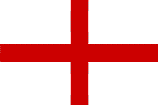
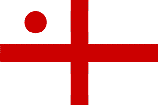
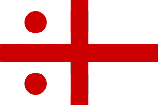
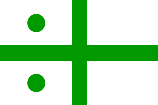
Flags of a Full Admiral, Vice Admiral and Rear Admiral
Royal Navy, United Kingdom (fotw); Flag of a Rear Admiral South African Navy, South Africa (fotw)
- BALZAUS
- See bauceant.
- BAND
- See stripe and
Appendix VI.
- BANDERA DE CEREMONIA
- See indoor flag.
- BANDERA DE GUERRA
- See war flag 1) and
war flag 2).
- BANDERARIUS (BANDARENSIS, BANDONARIUS or BANDEZATUS)
- A medieval term, now obsolete, for a standard bearer.
- BANDERIUM
- A medieval term, now obsolete, for a military unit serving under the banner
of a feudal lord (see also banner 1),
banneret 2), and
vexillation).
- BANDEROLE (BANDEROL, BANDEROLLE, BANDROL, BANDROLE
or BANDERVILLE)
- 1) A term, now obsolete, for a small banner (see also
banner 1)).
- 2) A streamer or ribbon often with an inscription normally used alone
(as on a crosier) rather than as an accessory to a flag an orarium (see also
scarf, pencel and
streamer).
- 3) A heraldic term for the streamer attached to a helmet or crest (see also
crest, pencel
and helm).
- 4) A small flag flown as an accessory to a larger one.
Please note - not to be confused with
bannerole.
- BANDUM (or BANDERIA)
- 1) A medieval term, now obsolete, for a small banner (see also
banneret and
bannerette).
- 2) The Latin form of the Greek bandon which was a Byzantine military flag.
Please note, that banderia is a plural form of bandum,
and that it has been suggested 1) may have been Latinized from a Celtic original.
- BANERA (BANERIA, BANERIUM or BANNERIUM)
- A medieval term, now obsolete, for a banner.
- BANNER OF ARMS
- See banner 1).
- BANNER OF COUNCIL
- In English naval usage, now obsolete, a flag (often the Royal Standard) that
was used prior to the invention of a signal code to summon a council of war aboard
the flagship (see also flagship).
![[badge illustration]](../images/v/vxt-d032.gif)
English Royal Standard c1400 (Martin Grieve)
Please note that a banner of council first appeared
in English sources during the first half of the 14th Century (dates of between
1337 and 1351 are suggested), however, please also note that use of a flag with
this meaning was by no means limited to Englands navy, with instructions for
a combined Mediterranean galley fleet of 1366 being just one example.
- BANNER OF THE REALM
- A translation of the Dutch rijksvaandel and proposed translation of the Norwegian term riksbanner -
but see coronation flags.
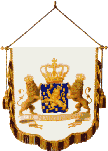
Rijksvaandel of the Netherlands (fotw)
- BANNER OF VICTORY
- 1) Specifically, the flag which (traditionally) was first raised by victorious Russian
forces over the Reichstag, Berlin on 20 April 1945, and which is preserved in the Central
Museum of the Armed Forces, Moscow with a reproduction being displayed in the
annual Victory Day Celebration but see note below (also also red flag 3)).
- 2) Generically, the flag of any combatant who is victorious in a battle or in a war (see also
banner 8)).
![[Russian banner of victory]](../images/v/vxt-d501.gif)
Banner Raised Over The Reichstag, Berlin 1945 (fotw)
Please note with regard to 1) that the Cyrillic wording on the flag
150 стр. Ордена Кутузова II ст.
идрицк. див. 79 С.К. 3У.А.IБ.Ф
means 150th Rifle Idrickaβ
Division (Awarded Order of Kutusov, II Degree), 79th Joint Corps, 3rd Shock
Army, 1st Byelorussian Front, and that from 2005 any such flags officially
displayed at the Victory Day Celebrations will not show the hammer and sickle.
![[badge illustration]](../images/v/vxt-d028.gif)




![[badge illustration]](../images/v/vxt-d032.gif)
![[Russian banner of victory]](../images/v/vxt-d501.gif)

